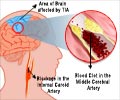Healthcare and personal costs to support survivors of stroke remains high 10 years on, new data has indicated.

Previous studies based on estimating the lifetime costs using patient data up to 5 years after a stroke, suggested that costs peaked in the first year and then declined in subsequent years.
The new findings, led by Associate Professor Dominique Cadilhac and Professor Amanda Thrift from the School of Clinical Sciences at Monash Health, provides evidence that healthcare and personal expenses associated with a stroke continue to be substantial over time. The greatest ongoing costs being for aged care facilities and informal care.
243 patients who experienced an ischemic stroke – the most common type of stroke, and 43 patients with intracerebral hemorrhage stroke who went on to survive for 10 years or more were interviewed to calculate annual costs as part of the North East Melbourne Stroke Incidence Study.
Average annual healthcare costs 10 years after an ischemic stroke were $5,418 (AUD) – broadly similar to costs estimated between 3 and 5 years ($5,545).
Whereas previous estimates for annual healthcare costs for intracerebral hemorrhage stroke ten years after stroke onset were $6,101, Professor Cadilhac's team found the true cost was $9,032 far higher than costs calculated at 3 to 5 years ($6,101) because of a greater need for aged care facilities 10 years on.
Advertisement
"Stroke affects thousands of people and in many cases requires ongoing medical support. We know the condition is costly to treat especially in the first year, but little data existed on the long term healthcare and personal costs, as well as the impact on the workforce, until now," she said.
Advertisement
437,000 people in Australia are living with the effects of stroke and this figure is predicted to increase to 709,000 in 2032. It's estimated that 51,000 Australians will suffer a new or recurrent stroke this year – equivalent to one stroke every 10 minutes.
It's hoped that the new data will provide important current practice estimates for economic evaluations of the potential impact of new or existing interventions to reduce the impact of stroke.
Professor Cadilhac said the study suggests the long-term medical costs for stroke patients with stroke have been underestimated.
"The large majority of strokes that are due to modifiable risk factors, such as high blood pressure or diabetes," she said.
"This study shows we need to have a renewed focus on stroke prevention because the costs of providing care to people who suffer from a stroke are unlikely to diminish."
"Prompt treatment is also essential because the sooner a person receives treatment for a stroke; the less damage to the brain is likely to happen. Health care providers can ensure the maximum opportunity for reducing the likelihood of disability and death in their patients after stroke by providing best practice care, such as access to Stroke Care Units," Professor Cadilhac said.
Source-Eurekalert














